#gerald eichstadt
Photo
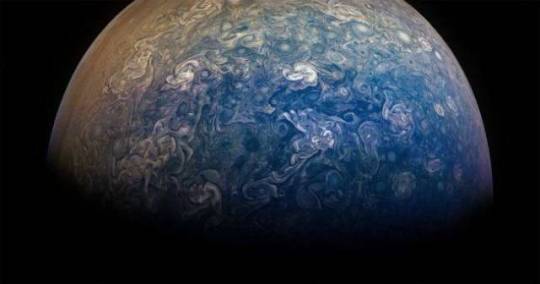


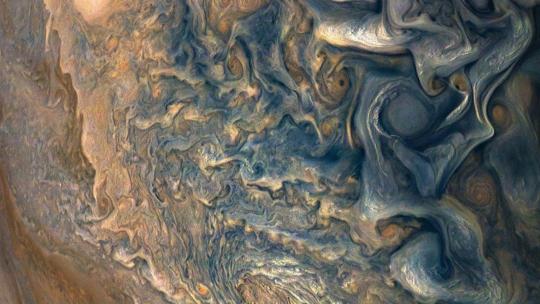
Jupiter by ‘Juno’ spacecraft in 2018
NASA / SWRI / MSSS / Gerald Eichstadt / Sean Doran
#art#photography#cosmos#cosmic#universe#mystery#jupiter#spacecraft#Juno#nasa#SWRI#MSSS#sean doran#gerald eichstadt#2018#science#surreal#forms
9 notes
·
View notes
Video
youtube
2024 April 21
Perijove 16: Passing Jupiter
Video Credit & License: NASA, Juno, SwRI, MSSS, Gerald Eichstadt;
Music: The Planets, IV. Jupiter (Gustav Holst); USAF Heritage of America Band (via Wikipedia)
Explanation: Watch Juno zoom past Jupiter. NASA's robotic spacecraft Juno is continuing on its now month-long, highly-elongated orbits around our Solar System's largest planet. The featured video is from perijove 16, the sixteenth time that Juno passed near Jupiter since it arrived in mid-2016. Each perijove passes near a slightly different part of Jupiter's cloud tops. This color-enhanced video has been digitally composed from 21 JunoCam still images, resulting in a 125-fold time-lapse. The video begins with Jupiter rising as Juno approaches from the north. As Juno reaches its closest view -- from about 3,500 kilometers over Jupiter's cloud tops -- the spacecraft captures the great planet in tremendous detail. Juno passes light zones and dark belts of clouds that circle the planet, as well as numerous swirling circular storms, many of which are larger than hurricanes on Earth. As Juno moves away, the remarkable dolphin-shaped cloud is visible. After the perijove, Jupiter recedes into the distance, now displaying the unusual clouds that appear over Jupiter's south. To get desired science data, Juno swoops so close to Jupiter that its instruments are exposed to very high levels of radiation.
∞ Source: apod.nasa.gov/apod/ap240421.html
67 notes
·
View notes
Photo
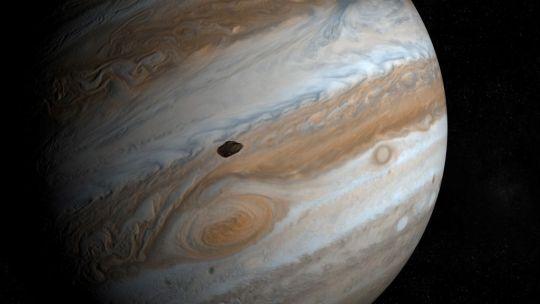
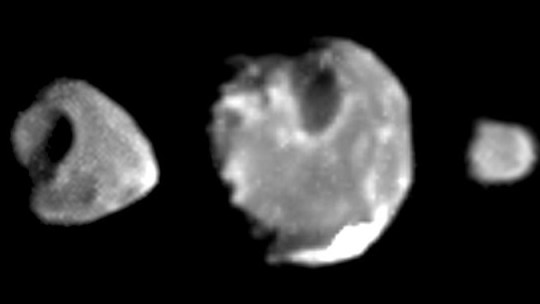

Amalthea: Facts about Jupiter’s unusual inner moon | Space
1st image:
Artist's illustration of Amalthea orbiting Jupiter. (Image credit: Ianm35 via Getty Images)
2nd image:
Jovian moon Amalthea (center) as photographed by NASA’s Galileo spacecraft in January 2000. Beside it are Thebe (left) and Metis (right). (Image credit: NASA/JPL/Cornell University)
3rd image:
Amalthea casts a shadow on Jupiter in this image captured by NASA's Juno spacecraft. (Image credit: Enhanced Image by Gerald Eichstadt and Sean Doran (CC BY-NC-SA) based on images provided Courtesy of NASA/JPL-Caltech/SwRI/MSSS)
2 notes
·
View notes
Text
Jüpiter Yakın Geçişi 16: Jüpiter’i Geçmek
Günün Astronomi Görseli 21 Nisan 2024
Video: NASA, Juno, SwRI, MSSS, Gerald Eichstadt; Müzik: The Planets, IV. Jupiter (Gustav Holst); USAF Heritage of America Band (via Wikipedia)
Juno’nun Jüpiter’in yanından geçişini izleyin. NASA’nın robotik uzay aracı Juno, Güneş Sistemi’nin en büyük gezegeni etrafındaki şimdilerde bir ay süren, fazlaca uzun dönüşlerine devam ediyor. Bu video, Juno’nun…

View On WordPress
#apod#astronomi#astronomy#bilim#gökyüzü#Juno#jüpiter#Nasa#repost#science#sky#space#uzay#uzaydanhaberler
0 notes
Link
4 Min Read Spot the King of Planets: Observe Jupiter NASA’s Juno spacecraft Credits: NASA/JPL-Caltech/SwRI/MSSS/Gerald Eichstadt/Sean Doran Jupiter is our solar system’s undisputed king of the planets! Jupiter is bright and easy to spot from our vantage point on Earth, helped by its massive size and banded, reflective cloud tops. Jupiter even possesses moons the size of planets: Ganymede, its largest, is bigger than the planet Mercury. What’s more, you can easily observe Jupiter and its moons with a modest instrument, just like Galileo did over 400 years ago. Jupiter’s position as our solar system’s largest planet is truly earned; you could fit 11 Earths along Jupiter’s diameter, and in case you were looking to fill up Jupiter with some Earth-size marbles, you would need over 1300 Earths to fill it up – and that would still not be quite enough! However, despite its awesome size, Jupiter’s true rule over the outer solar system comes from its enormous mass. If you took all the planets in our solar system and put them together, they would still only be half as massive as Jupiter all by itself. Jupiter’s mighty mass has shaped the orbits of countless comets and asteroids. Its gravity can fling these tiny objects towards our inner solar system and also draw them into itself, as famously observed in 1994 when Comet Shoemaker-Levy 9, drawn towards Jupiter in previous orbits, smashed into the gas giant’s atmosphere. Its multiple fragments slammed into Jupiter’s cloud tops with such violence that the fireballs and dark impact spots were not only seen by NASA’s orbiting Galileo probe, but also observers back on Earth! Jupiter’s Great Red Spot is close to the size of Earth. Credit: NASA Jupiter is easy to observe at night with our unaided eyes, as well-documented by the ancient astronomers who carefully recorded its slow movements from night to night. It can be one of the brightest objects in our nighttime skies, bested only by the Moon, Venus, and occasionally Mars, when the red planet is at opposition. That’s impressive for a planet that, at its closest to Earth, is still over 365 million miles (587 million km) away. It’s even more impressive that the giant world remains very bright to Earthbound observers at its furthest distance: 600 million miles (968 million km)! While the King of Planets has a coterie of 95 known moons, only the four large moons that Galileo originally observed in 1610 – Io, Europa, Ganymede, and Calisto – can be easily observed by Earth-based observers with very modest equipment. These are called, appropriately enough, the Galilean moons. Most telescopes will show the moons as faint star-like objects neatly lined up close to bright Jupiter. Most binoculars will show at least one or two moons orbiting the planet. Small telescopes will show all four of the Galilean moons if they are all visible, but sometimes they can pass behind or in front of Jupiter, or even each other. Telescopes will also show details like Jupiter’s cloud bands and, if powerful enough, large storms like its famous Great Red Spot, and the shadows of the Galilean moons passing between the Sun and Jupiter. Sketching the positions of Jupiter’s moons during the course of an evening – and night to night – can be a rewarding project! You can download an activity guide from the Astronomical Society of the Pacific at bit.ly/drawjupitermoons NASA’s Juno mission currently orbits Jupiter, one of just nine spacecraft to have visited this awesome world. Juno entered Jupiter’s orbit in 2016 to begin its initial mission to study this giant world’s mysterious interior. The years have proven Juno’s mission a success, with data from the probe revolutionizing our understanding of this gassy world’s guts. Juno’s mission has since been extended to include the study of its large moons, and since 2021 the plucky probe, increasingly battered by Jupiter’s powerful radiation belts, has made close flybys of the icy moons Ganymede and Europa, along with volcanic Io. In Fall 2024 NASA will launch the Europa Clipper mission to study this world and its potential to host life inside its deep subsurface oceans in much more detail. Visit https://science.nasa.gov/jupiter/ to learn about the latest discoveries from Juno and NASA’s missions involving Jupiter! Originally posted by Dave Prosper: February 2023 Last Updated by Kat Troche: February 2024
0 notes
Text
un splendide survol de Jupiter par la sonde Juno. Admirez l'atmosphère turbulente de la planète géante, qui ressemble parfois à une œuvre d'art ! 🤩
© NASA, Juno, SwRI, MSSS, Gerald Eichstadt
0 notes
Text

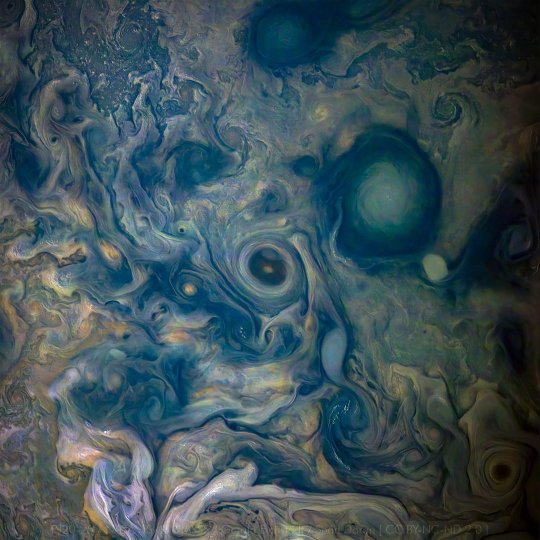
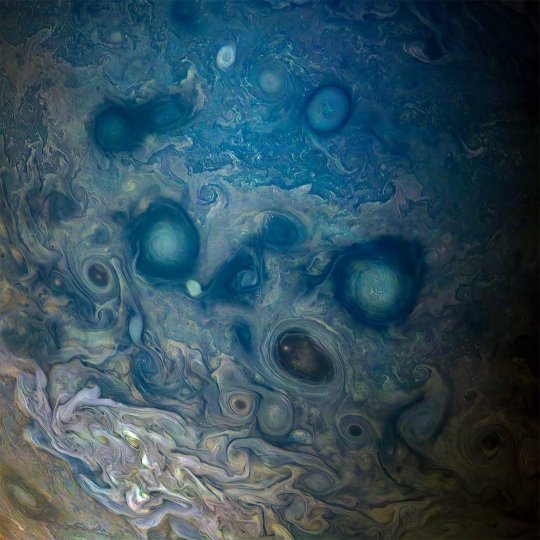

7 notes
·
View notes
Photo

Blue Jovian clouds on Jupiter, taken from 11,747 miles (18,906 km) away by the Juno spacecraft. NASA/JPL-Caltech/SwRI/MSSS/Gerald Eichstadt/Sean Doran
25 notes
·
View notes
Text
Latest Juno data study reveals an unexpected feature of Jupiter's Great Red Spot
https://sciencespies.com/space/latest-juno-data-study-reveals-an-unexpected-feature-of-jupiters-great-red-spot/
Latest Juno data study reveals an unexpected feature of Jupiter's Great Red Spot

Jupiter‘s iconic Great Red Spot may extend even deeper into the planet’s atmosphere than scientists thought.
NASA’s Juno spacecraft zipped past the Great Red Spot – an anticyclone large enough to swallow Earth – twice in 2019. Measurements from those flights are now revealing the storm’s structure in far more detail than telescope images can show. That data suggests that the vortex probably extends anywhere from 186 to 310 miles deep (200 to 500 kilometers) – far below Jupiter’s clouds.
The Juno probe has been circling Jupiter, flying past its poles and even some of its moons, for the last five years. Prior to its latest visits to the Great Red Spot, the spacecraft hadn’t flown past the giant storm since July 2017.

2019 Hubble Space Telescope photo of Jupiter and its Great Red Spot. (A. Simon/M.H. Wong/NASA/ESA et al.)
Back then, Juno’s measurements indicated that the vortex extended about 200 miles (322km) into Jupiter’s atmosphere. That was an astonishing depth to scientists at the time – it’s about 50 to 100 times deeper than Earth’s oceans. But now, Juno’s latest flybys have revealed that the storm may extend far further down than that.
“That means it’s a gigantic storm,” Yohai Kaspi, a Juno researcher at the Weizmann Institute of Science in Israel, told The Verge. “If you would put this storm on Earth, it would extend all the way to the space station. So it’s just a monster.”

(Gerald Eichstadt/Justin Cowart/NASA/JPL-Caltech/SwRI/MSSS)
Above: Animated Great Red Spot based on velocity data from Juno and wind modelling.
The researchers published their findings in the journal Science on Thursday.
Mysteriously, the jet streams surrounding the Great Red Spot extend even deeper – nearly 1,900 miles (about 3,000 km) below Jupiter’s cloud surface. The researchers aren’t sure why.
They do know, however, that those jets – distinct bands of gas wrapping around the planet – are keeping the Great Red Spot alive. The storm is wedged between two jet streams that move in opposite directions, powering the spin of the vortex.

Tumultuous clouds surrounding Jupiter’s Great Red Spot. (A. Simon/NASA/ESA et al)
“It’s surprising that [the Great Red Spot] goes so deep… but it’s also surprising that it doesn’t go as deep as the jets,” Marzia Parisi, a Juno scientist at NASA’s Jet Propulsion Laboratory, told The Verge.
“So something is happening at 500 kilometers that is basically dampening the Great Red Spot.”
The Great Red Spot is constantly changing. It has been shrinking and becoming more circular since astronomers began observing it about 150 years ago. Just last month, another group of scientists discovered that winds in the cyclone’s outer band have sped up over the last decade, while its inner regions have slowed.
Measurements from NASA’s Hubble Space Telescope have indicated that the Great Red Spot is getting taller as it shrinks.
Some scientists have suggested the storm will collapse and disappear in just a few decades due to its shrinking size, but other researchers disagree.
For its part, Juno is set to continue orbiting and studying Jupiter for another four years.
This article was originally published by Business Insider.
More from Business Insider:
#Space
2 notes
·
View notes
Text
Jupiter's Cloud Tops: From High to Low
NASA - JUNO Mission logo.
Oct. 29, 2019
This view from NASA's Juno spacecraft captures colorful, intricate patterns in a jet stream region of Jupiter's northern hemisphere known as "Jet N3."
Jupiter's cloud tops do not form a simple, flat surface. Data from Juno helped scientists discover that the swirling bands in the atmosphere extend deep into the planet, to a depth of about 1,900 miles (3,000 kilometers). At center right, a patch of bright, high-altitude "pop-up" clouds rises above the surrounding atmosphere.
Juno spacecraft orbiting Jupiter
Citizen scientist Gerald Eichstädt created this enhanced-color image using data from the spacecraft's JunoCam imager. The original image was taken on May 29, 2019, at 1:01 a.m. PDT (4:01 a.m. EDT) as the Juno spacecraft performed its 20th close flyby of Jupiter. At the time the image was taken, the spacecraft was about 6,000 miles (9,700 kilometers) from the tops of the clouds, at a latitude of 39 degrees north.
Juno: http://www.nasa.gov/mission_pages/juno/main/index.html
Image, Animation, Credit:NASA/Yvette Smith/JPL-Caltech/SwRI/MSSS/Gerald Eichstadt.
Greetings, Orbiter.ch
Full article
14 notes
·
View notes
Photo

A Jovian Cyclone⠀ ⠀ A cyclonic storm churns through Jupiter's northern hemisphere in this new view from NASA's Juno spacecraft. The swirling cloud formation looks a lot like a hurricane on Earth, with fluffy clouds popping up from the storm's spiral arms. Juno captured this view with its JunoCam imager on Feb. 12, when it was about 5,000 miles (8,000 kilometers) above Jupiter's cloud tops. ⠀ ⠀ Image Credit: NASA/JPL-Caltech/SwRI/MSSS/Gerald Eichstadt/Sean Doran⠀ Text Credit: Hanneke Weitering via Instagram http://bit.ly/2OYLdoq
38 notes
·
View notes
Video
youtube
2022 August 28
Perijove 11: Passing Jupiter
Video Credit: License: NASA, Juno, SwRI, MSSS, Gerald Eichstadt; Music: Moonlight Sonata (Ludwig van Beethoven)
Explanation: Here comes Jupiter! NASA's robotic spacecraft Juno is continuing on its highly-elongated orbits around our Solar System's largest planet. The featured video is from perijove 11 in early 2018, the eleventh time Juno has passed near Jupiter since it arrived in mid-2016. This time-lapse, color-enhanced movie covers about four hours and morphs between 36 JunoCam images. The video begins with Jupiter rising as Juno approaches from the north. As Juno reaches its closest view -- from about 3,500 kilometers over Jupiter's cloud tops -- the spacecraft captures the great planet in tremendous detail. Juno passes light zones and dark belt of clouds that circle the planet, as well as numerous swirling circular storms, many of which are larger than hurricanes on Earth. After the perijove, Jupiter recedes into the distance, then displaying the unusual clouds that appear over Jupiter's south. To get desired science data, Juno swoops so close to Jupiter that its instruments are exposed to very high levels of radiation.
∞ Source: apod.nasa.gov/apod/ap220828.html
42 notes
·
View notes
Photo
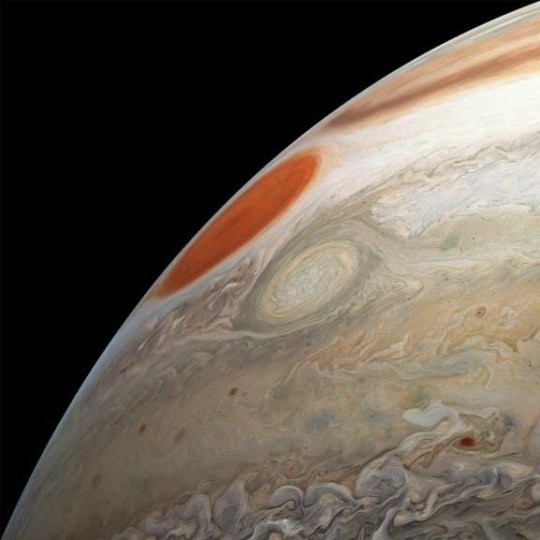
Júpiter e sua Grande Mancha Vermelha vistos a partir do seu hemisfério sul. . Jupiter and its Giant Red Spot as seen from the southern hemisphere. . Credit: NASA/JPL-Caltech/SwRI/MSSS/Gerald Eichstadt/Sean Doran . #nasa #juno #jupiter #great #red #spot #grande #mancha #vermelha #space #espaço #astronomia #astronomy #astrogram #instagood #picoftheday #saturday https://www.instagram.com/p/Bs1BWnDBOfT/?utm_source=ig_tumblr_share&igshid=rlsxgi694tj5
#nasa#juno#jupiter#great#red#spot#grande#mancha#vermelha#space#espaço#astronomia#astronomy#astrogram#instagood#picoftheday#saturday
75 notes
·
View notes
Video
PERIJOVE 11: JÜPİTER'İ GEÇMEK
Karşınızda Jüpiter! NASA’nın robotik uzay aracı Juno, Güneş Sistemi’nin en büyük gezegeni etrafındaki 53 gün süren, fazlaca uzun dönüşlerine devam ediyor. Bu video 2018’in başlarındaki 11’inci geçişten, Juno’nun 2016’nın ortalarındaki varışından bu yana Jüpiter’in yakınından onbirinci kez geçişinden. Renkleri geliştirilmiş hızlandırılmış video, yaklaşık dört saati ve 36 JunoCam görüntüsü arasındaki geçişleri kapsıyor. Video, Juno kuzeyden yaklaşırken Jüpiter’in yükselmesiyle başlıyor. Juno, Jüpiter’in bulut tepelerinden yaklaşık 3500 kilometre yukarıda en yakın görüntüsüne ulaşırken dev gezegeni çok detaylı şekilde yakalıyor. Juno gezegeni çevreleyen aydınlık kuşaklar ve bulutlardan karanlık bir kuşakla birlikte pek çoğu Dünya’daki kasırgalardan daha büyük olan dairesel fırtınaları geçiyor. Yakın geçişten sonra Jüpiter uzakta yavaşça kayboluyor ve güneyinde beliren sıra dışı bulutları göstermeye başlıyor. Juno istenen bilimsel verileri almak için Jüpiter’e o kadar yakın geçiyor ki üzerindeki cihazları çok yüksek seviyelerde radyasyona maruz kalıyor.
Video: NASA, Juno, SwRI, MSSS, Gerald Eichstadt; Muzik: Moonlight Sonata (Ludwig van Beethoven)
#apod#nasa#sky#space#astronomy#science#repost#gökyüzü#astronomi#uzay#bilim#uzaydanhaberler#juno#jupiter
8 notes
·
View notes
Photo

Gravitational Forecasting
On Earth the atmosphere accounts for roughly 1/1,000,000th of the mass of the planet (i.e. not much at all). On Jupiter however, it’s a different story.
The horizontal bands that cross Jupiter have long been known to be giant jet streams with forces going up to 100 times that of any hurricane on Earth. How similar are these atmospheric forces to those found on Earth? It turns out, probably pretty different.
Researchers from NASA’s Juno mission team (led by Professor Yohai Kaspi) have found that the gravity measurements from their spacecraft indicated a strangely deformed gravity field. In fact, they found that about 1% of Jupiter’s mass is in its extensive atmosphere. This means that a gravitationally detectable amount of mass is moving in these currents. The bands (which are visible with an 8″ or so telescope!) on Jupiter actually extend as far as 3,000 km below the surface. Impressive.
I admit to writing a rather “clickbaity” name for this post but who’s to say, perhaps some daring planetary scientists will try to come up with a system of weather forecasting based on gravitational anomalies? The future is now!
(Image credit: NASA/SWRI/MSSS/Gerald Eichstadt/Sean Doran)
79 notes
·
View notes
Text
Jupiter's Great Red Spot Is More Than 50 Times Deeper Than Earth's Ocean

A wind-movement model animates a mosaic image of Jupiter's Great Red Spot made from JunoCam images.
Credit: NASA/JPL-Caltech/SwRI/MSSS/Gerald Eichstadt/Justin Cowart
A slowly shrinking storm
Despite being long-lived, Jupiter's Great Red Spot hasn't been a model of consistency. While the massive feature has swirled across Jupiter for at least 200 years — possibly 350, if early telescope observations describe the same storm — it has been slowly shrinking. During the 19th century, and again when NASA's Voyager 1 and 2 spacecraft sped by on the way to Saturn in 1979, the spot stretched well over two Earths wide. But Earth-based measurements today put the spot at only a third of the size measured by the Voyager probes.
Juno arrived at Jupiter on July 4, 2016, after a nearly five-year flight. Since then, the spacecraft has made eight science passes over the gas giant, with a ninth scheduled for this Saturday (Dec. 16). In July 2017, it made its first close flyby of the Great Red Spot. The spacecraft's Microwave Radiometer probed the clouds surrounding the gigantic storm, measuring their depth in the atmosphere.

Juno's microwave radiometer instrument provided this look down into Jupiter's Great Red Spot. Each of the instrument's six channels detects microwaves from a different depth within the planet. Credit: NASA/JPL-Caltech/MSSS
Read more ~ Space.com
321 notes
·
View notes